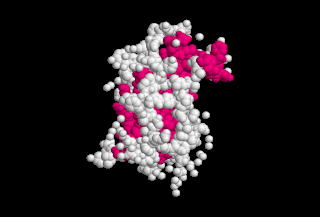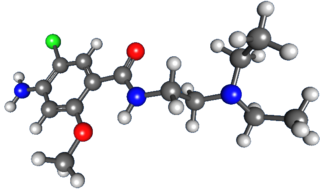
Growth hormone (GH) or somatotropin, also known as human growth hormone in its human form, is a peptide hormone that stimulates growth, cell reproduction, and cell regeneration in humans and other animals. It is thus important in human development. GH also stimulates production of IGF-1 and increases the concentration of glucose and free fatty acids. It is a type of mitogen which is specific only to the receptors on certain types of cells. GH is a 191-amino acid, single-chain polypeptide that is synthesized, stored and secreted by somatotropic cells within the lateral wings of the anterior pituitary gland.

Loperamide, sold under the brand name Imodium, among others, is a medication used to decrease the frequency of diarrhea. It is often used for this purpose in irritable bowel syndrome, inflammatory bowel disease and short bowel syndrome. It is not recommended for those with blood in the stool, mucus in the stool, or fevers. The medication is taken by mouth.

Metoclopramide is a medication used for stomach and esophageal problems. It is commonly used to treat and prevent nausea and vomiting, to help with emptying of the stomach in people with delayed stomach emptying, and to help with gastroesophageal reflux disease. It is also used to treat migraine headaches.
Controversies regarding the use of human growth hormone (HGH) as treatment method have centered on the claims, products, and businesses related to the use of growth hormone as an anti-aging therapy. Most of these controversies fall into two categories:
- Claims of exaggerated, misleading, or unfounded assertions that growth hormone treatment safely and effectively slows or reverses the effects of aging.
- The sale of products that fraudulently or misleadingly purport to be growth hormone or to increase the user's own secretion of natural human growth hormone to a beneficial degree.

Hydroxyzine, sold under the brand names Atarax and Vistaril among others, is an antihistamine medication. It is used in the treatment of itchiness, insomnia, anxiety, and nausea, including that due to motion sickness. It is used either by mouth or injection into a muscle.

Adrafinil, sold under the brand name Olmifon, is a wakefulness-promoting medication that was formerly used in France to improve alertness, attention, wakefulness, and mood, particularly in the elderly. It was also used off-label by individuals who wished to avoid fatigue, such as night workers or others who needed to stay awake and alert for long periods of time. Additionally, the medication has been used non-medically as a novel vigilance-promoting agent.

Sibutramine, formerly sold under the brand name Meridia among others, is an appetite suppressant which has been discontinued in many countries. It works as a serotonin–norepinephrine reuptake inhibitor similar to a tricyclic antidepressant. Until 2010, it was widely marketed and prescribed as an adjunct in the treatment of obesity along with diet and exercise. It has been associated with increased cardiovascular diseases and strokes and has been withdrawn from the market in 2010 in several countries and regions including Australia, Canada, China, the European Union, Hong Kong, India, Mexico, New Zealand, the Philippines, Thailand, the United Kingdom, and the United States. However, the drug remains available in some countries.

Conivaptan, sold under the brand name Vaprisol, is a non-peptide inhibitor of the receptor for anti-diuretic hormone, also called vasopressin. It was approved in 2004 for hyponatremia. The compound was discovered by Astellas and marked in 2006. The drug is now marketed by Cumberland Pharmaceuticals, Inc.

Off-label use is the use of pharmaceutical drugs for an unapproved indication or in an unapproved age group, dosage, or route of administration. Both prescription drugs and over-the-counter drugs (OTCs) can be used in off-label ways, although most studies of off-label use focus on prescription drugs.

Ana Aslan was a Romanian biologist and physician of Armenian descent, born Anna Aslanyan, specialist in gerontology, academician from 1974 and the director of the National Institute of Geriatrics and Gerontology.
Methylphenobarbital (INN), also known as mephobarbital and mephobarbitone (BAN), marketed under brand names such as Mebaral, Mephyltaletten, Phemiton, and Prominal, is a drug which is a barbiturate derivative and is used primarily as an anticonvulsant, but also as a sedative and anxiolytic. It is the N-methylated analogue of phenobarbital and has similar indications, therapeutic value, and tolerability.
714-X, also referred to as 714X or trimethylbicyclonitramineoheptane chloride, is a mixture of substances manufactured by CERBE Distribution Inc and sold as an alternative medical treatment which is claimed to cure cancer, multiple sclerosis, fibromyalgia and other diseases. There is no scientific evidence that 714-X is effective in treating any kind of cancer, and its marketing is considered health fraud in the US.
The American Academy of Anti-Aging Medicine (A4M) is a United States 501(c)(3) nonprofit organization that promotes the field of anti-aging medicine, and the organization trains and certifies physicians in this specialty. As of 2011, approximately 26,000 practitioners had been given A4M certificates. The field of anti-aging medicine is not recognized by established medical organizations, such as the American Board of Medical Specialties (ABMS) and the American Medical Association (AMA). The academy's activities include lobbying and public relations. The A4M was founded in 1993 by osteopathic physicians Robert M. Goldman and Ronald Klatz, and as of 2013 claimed 26,000 members from 120 countries.
Procaine benzylpenicillin also known as penicillin G procaine, is an antibiotic useful for the treatment of a number of bacterial infections. Specifically it is used for syphilis, anthrax, mouth infections, pneumonia, diphtheria, cellulitis, and animal bites. It is given by injection into a muscle.

Peter Thomas DeMarco was an American physician who graduated from Albright College in Pennsylvania and achieved his doctor of medicine degree in 1957 from Hahnemann Medical College of Philadelphia, Pennsylvania.

Farmec is the largest cosmetics manufacturer in Romania. The company manufactures and sells beauty products, household hygiene products and other chemical products. Farmec is headquartered in Cluj-Napoca, where the company hosts a variety of its factors of production. As of 2013, the company possesses a large production plant in Cluj-Napoca and employs 600 people. Farmec benefits of an economy of scale.

1,3-Dimethylbutylamine, is a stimulant drug structurally related to methylhexanamine where a butyl group replaces the pentyl group. The compound is an aliphatic amine.
Marketing of off-label use is advertising the use of drugs for purposes not approved by the regional government. The practice is often illegal and has led to most of the largest pharmaceutical settlements after Franklin v. Parke-Davis, in which a court ruled off-label marketing a violation of the False Claims Act.
The Fabunan Antiviral Injection (FAI) is a patent medicine sold by US-based Filipino doctors Ruben and Willie Fabunan, who claim it can treat dengue fever, chikungunya, dog bite, snakebite, and HIV/AIDS.












